Strategic Quality and System Management Report: Crosby's QMMG Analysis
VerifiedAdded on 2022/10/17
|11
|3444
|409
Report
AI Summary
This report provides an in-depth analysis of Crosby's Quality Management Maturity Grid (QMMG), a model for assessing the maturity of quality management within an organization. It outlines the five stages of QMMG: uncertainty, awakening, enlightenment, wisdom, and certainty, detailing the characteristics of each stage. The report discusses the advantages and disadvantages of using QMMG as a diagnostic and assessment tool, highlighting its value in quality measurement, management commitment, and quality awareness. It also examines the application of QMMG to Telstra, illustrating how the model can be used to evaluate and improve quality management practices within the company. The report references relevant literature and provides a comprehensive understanding of QMMG's role in strategic quality and system management.

Strategic Quality and system management
Paraphrase This Document
Need a fresh take? Get an instant paraphrase of this document with our AI Paraphraser
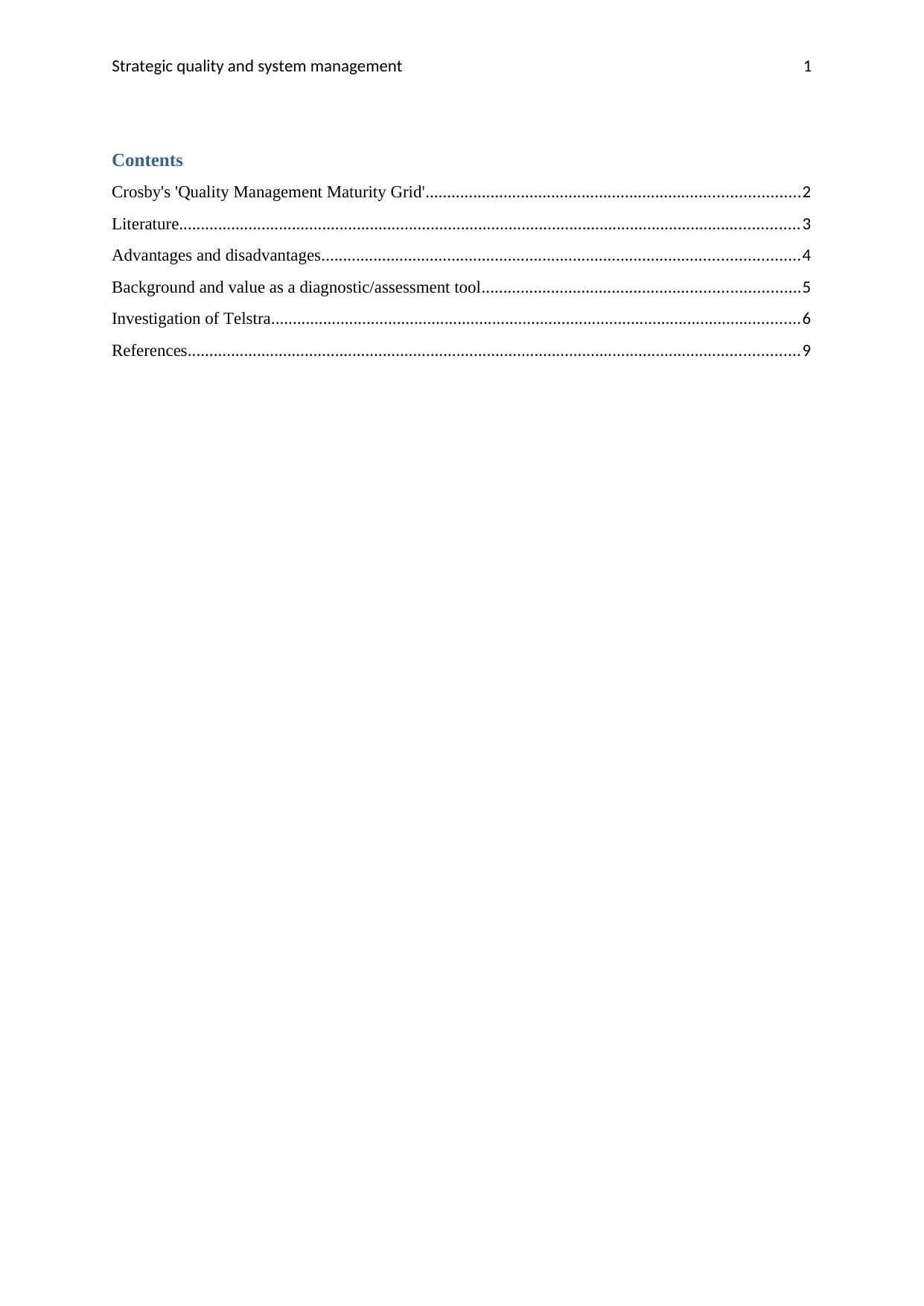
Strategic quality and system management 1
Contents
Crosby's 'Quality Management Maturity Grid'......................................................................................2
Literature...............................................................................................................................................3
Advantages and disadvantages..............................................................................................................4
Background and value as a diagnostic/assessment tool.........................................................................5
Investigation of Telstra..........................................................................................................................6
References.............................................................................................................................................9
Contents
Crosby's 'Quality Management Maturity Grid'......................................................................................2
Literature...............................................................................................................................................3
Advantages and disadvantages..............................................................................................................4
Background and value as a diagnostic/assessment tool.........................................................................5
Investigation of Telstra..........................................................................................................................6
References.............................................................................................................................................9
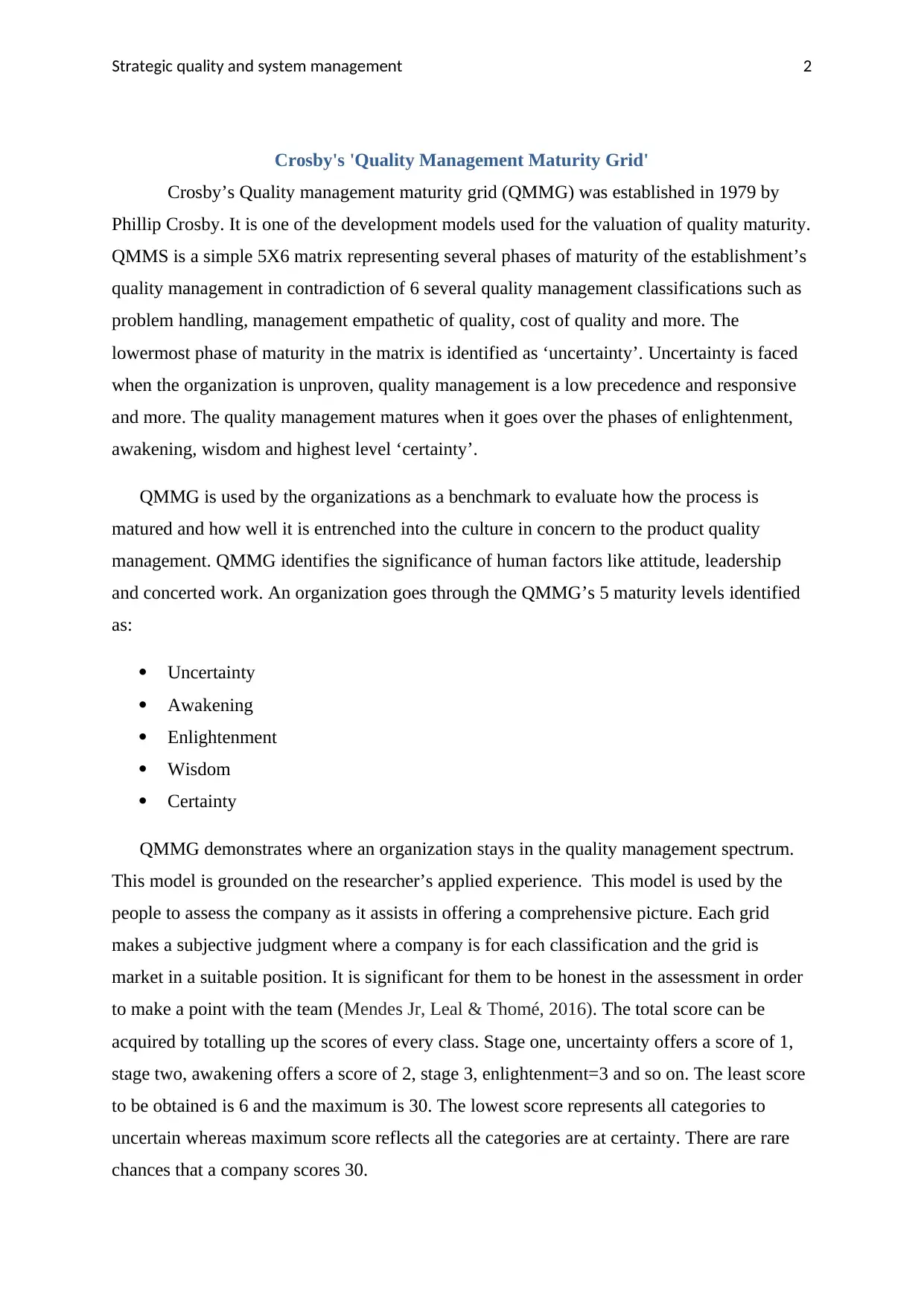
Strategic quality and system management 2
Crosby's 'Quality Management Maturity Grid'
Crosby’s Quality management maturity grid (QMMG) was established in 1979 by
Phillip Crosby. It is one of the development models used for the valuation of quality maturity.
QMMS is a simple 5X6 matrix representing several phases of maturity of the establishment’s
quality management in contradiction of 6 several quality management classifications such as
problem handling, management empathetic of quality, cost of quality and more. The
lowermost phase of maturity in the matrix is identified as ‘uncertainty’. Uncertainty is faced
when the organization is unproven, quality management is a low precedence and responsive
and more. The quality management matures when it goes over the phases of enlightenment,
awakening, wisdom and highest level ‘certainty’.
QMMG is used by the organizations as a benchmark to evaluate how the process is
matured and how well it is entrenched into the culture in concern to the product quality
management. QMMG identifies the significance of human factors like attitude, leadership
and concerted work. An organization goes through the QMMG’s 5 maturity levels identified
as:
Uncertainty
Awakening
Enlightenment
Wisdom
Certainty
QMMG demonstrates where an organization stays in the quality management spectrum.
This model is grounded on the researcher’s applied experience. This model is used by the
people to assess the company as it assists in offering a comprehensive picture. Each grid
makes a subjective judgment where a company is for each classification and the grid is
market in a suitable position. It is significant for them to be honest in the assessment in order
to make a point with the team (Mendes Jr, Leal & Thomé, 2016). The total score can be
acquired by totalling up the scores of every class. Stage one, uncertainty offers a score of 1,
stage two, awakening offers a score of 2, stage 3, enlightenment=3 and so on. The least score
to be obtained is 6 and the maximum is 30. The lowest score represents all categories to
uncertain whereas maximum score reflects all the categories are at certainty. There are rare
chances that a company scores 30.
Crosby's 'Quality Management Maturity Grid'
Crosby’s Quality management maturity grid (QMMG) was established in 1979 by
Phillip Crosby. It is one of the development models used for the valuation of quality maturity.
QMMS is a simple 5X6 matrix representing several phases of maturity of the establishment’s
quality management in contradiction of 6 several quality management classifications such as
problem handling, management empathetic of quality, cost of quality and more. The
lowermost phase of maturity in the matrix is identified as ‘uncertainty’. Uncertainty is faced
when the organization is unproven, quality management is a low precedence and responsive
and more. The quality management matures when it goes over the phases of enlightenment,
awakening, wisdom and highest level ‘certainty’.
QMMG is used by the organizations as a benchmark to evaluate how the process is
matured and how well it is entrenched into the culture in concern to the product quality
management. QMMG identifies the significance of human factors like attitude, leadership
and concerted work. An organization goes through the QMMG’s 5 maturity levels identified
as:
Uncertainty
Awakening
Enlightenment
Wisdom
Certainty
QMMG demonstrates where an organization stays in the quality management spectrum.
This model is grounded on the researcher’s applied experience. This model is used by the
people to assess the company as it assists in offering a comprehensive picture. Each grid
makes a subjective judgment where a company is for each classification and the grid is
market in a suitable position. It is significant for them to be honest in the assessment in order
to make a point with the team (Mendes Jr, Leal & Thomé, 2016). The total score can be
acquired by totalling up the scores of every class. Stage one, uncertainty offers a score of 1,
stage two, awakening offers a score of 2, stage 3, enlightenment=3 and so on. The least score
to be obtained is 6 and the maximum is 30. The lowest score represents all categories to
uncertain whereas maximum score reflects all the categories are at certainty. There are rare
chances that a company scores 30.
⊘ This is a preview!⊘
Do you want full access?
Subscribe today to unlock all pages.

Trusted by 1+ million students worldwide
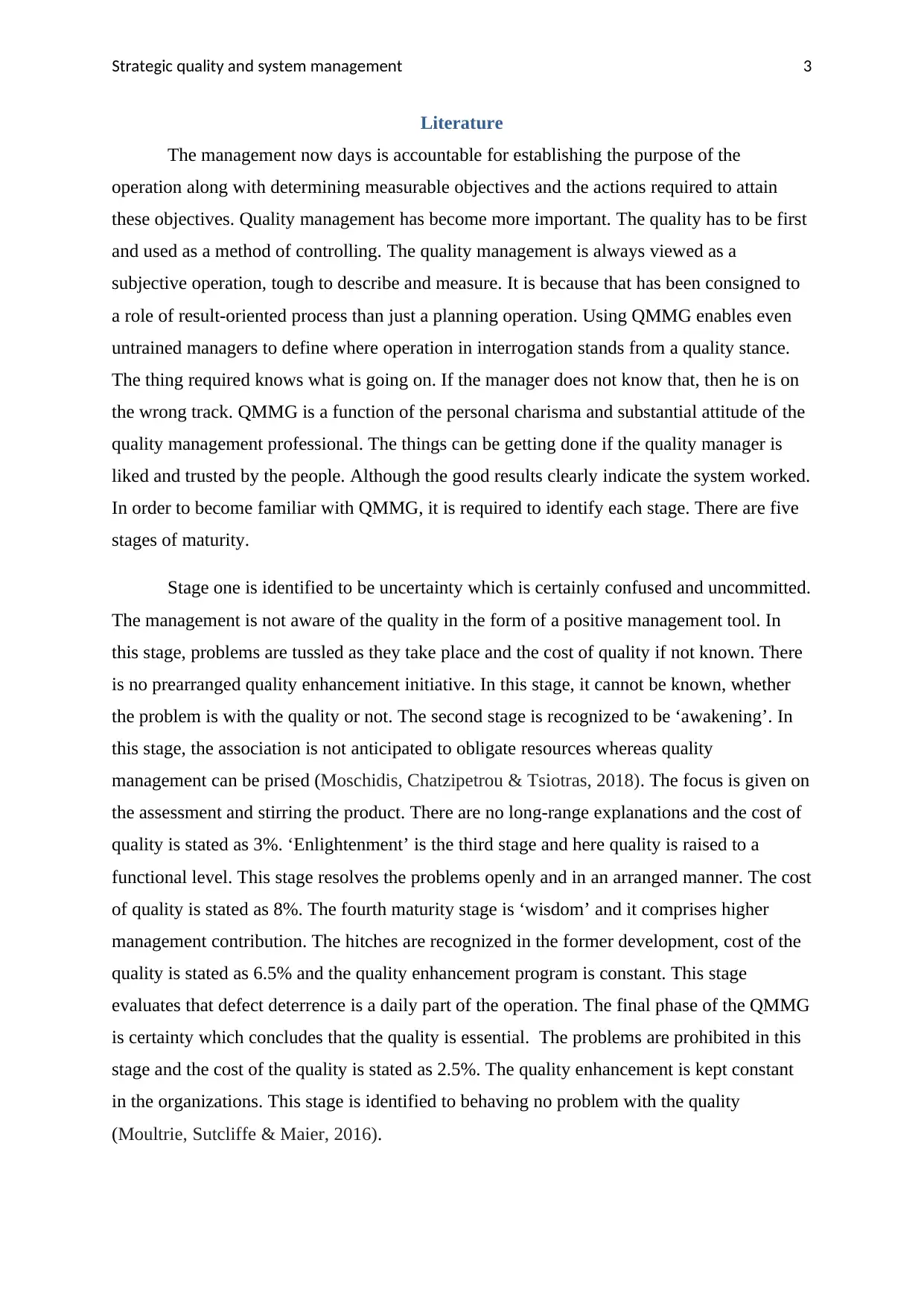
Strategic quality and system management 3
Literature
The management now days is accountable for establishing the purpose of the
operation along with determining measurable objectives and the actions required to attain
these objectives. Quality management has become more important. The quality has to be first
and used as a method of controlling. The quality management is always viewed as a
subjective operation, tough to describe and measure. It is because that has been consigned to
a role of result-oriented process than just a planning operation. Using QMMG enables even
untrained managers to define where operation in interrogation stands from a quality stance.
The thing required knows what is going on. If the manager does not know that, then he is on
the wrong track. QMMG is a function of the personal charisma and substantial attitude of the
quality management professional. The things can be getting done if the quality manager is
liked and trusted by the people. Although the good results clearly indicate the system worked.
In order to become familiar with QMMG, it is required to identify each stage. There are five
stages of maturity.
Stage one is identified to be uncertainty which is certainly confused and uncommitted.
The management is not aware of the quality in the form of a positive management tool. In
this stage, problems are tussled as they take place and the cost of quality if not known. There
is no prearranged quality enhancement initiative. In this stage, it cannot be known, whether
the problem is with the quality or not. The second stage is recognized to be ‘awakening’. In
this stage, the association is not anticipated to obligate resources whereas quality
management can be prised (Moschidis, Chatzipetrou & Tsiotras, 2018). The focus is given on
the assessment and stirring the product. There are no long-range explanations and the cost of
quality is stated as 3%. ‘Enlightenment’ is the third stage and here quality is raised to a
functional level. This stage resolves the problems openly and in an arranged manner. The cost
of quality is stated as 8%. The fourth maturity stage is ‘wisdom’ and it comprises higher
management contribution. The hitches are recognized in the former development, cost of the
quality is stated as 6.5% and the quality enhancement program is constant. This stage
evaluates that defect deterrence is a daily part of the operation. The final phase of the QMMG
is certainty which concludes that the quality is essential. The problems are prohibited in this
stage and the cost of the quality is stated as 2.5%. The quality enhancement is kept constant
in the organizations. This stage is identified to behaving no problem with the quality
(Moultrie, Sutcliffe & Maier, 2016).
Literature
The management now days is accountable for establishing the purpose of the
operation along with determining measurable objectives and the actions required to attain
these objectives. Quality management has become more important. The quality has to be first
and used as a method of controlling. The quality management is always viewed as a
subjective operation, tough to describe and measure. It is because that has been consigned to
a role of result-oriented process than just a planning operation. Using QMMG enables even
untrained managers to define where operation in interrogation stands from a quality stance.
The thing required knows what is going on. If the manager does not know that, then he is on
the wrong track. QMMG is a function of the personal charisma and substantial attitude of the
quality management professional. The things can be getting done if the quality manager is
liked and trusted by the people. Although the good results clearly indicate the system worked.
In order to become familiar with QMMG, it is required to identify each stage. There are five
stages of maturity.
Stage one is identified to be uncertainty which is certainly confused and uncommitted.
The management is not aware of the quality in the form of a positive management tool. In
this stage, problems are tussled as they take place and the cost of quality if not known. There
is no prearranged quality enhancement initiative. In this stage, it cannot be known, whether
the problem is with the quality or not. The second stage is recognized to be ‘awakening’. In
this stage, the association is not anticipated to obligate resources whereas quality
management can be prised (Moschidis, Chatzipetrou & Tsiotras, 2018). The focus is given on
the assessment and stirring the product. There are no long-range explanations and the cost of
quality is stated as 3%. ‘Enlightenment’ is the third stage and here quality is raised to a
functional level. This stage resolves the problems openly and in an arranged manner. The cost
of quality is stated as 8%. The fourth maturity stage is ‘wisdom’ and it comprises higher
management contribution. The hitches are recognized in the former development, cost of the
quality is stated as 6.5% and the quality enhancement program is constant. This stage
evaluates that defect deterrence is a daily part of the operation. The final phase of the QMMG
is certainty which concludes that the quality is essential. The problems are prohibited in this
stage and the cost of the quality is stated as 2.5%. The quality enhancement is kept constant
in the organizations. This stage is identified to behaving no problem with the quality
(Moultrie, Sutcliffe & Maier, 2016).
Paraphrase This Document
Need a fresh take? Get an instant paraphrase of this document with our AI Paraphraser
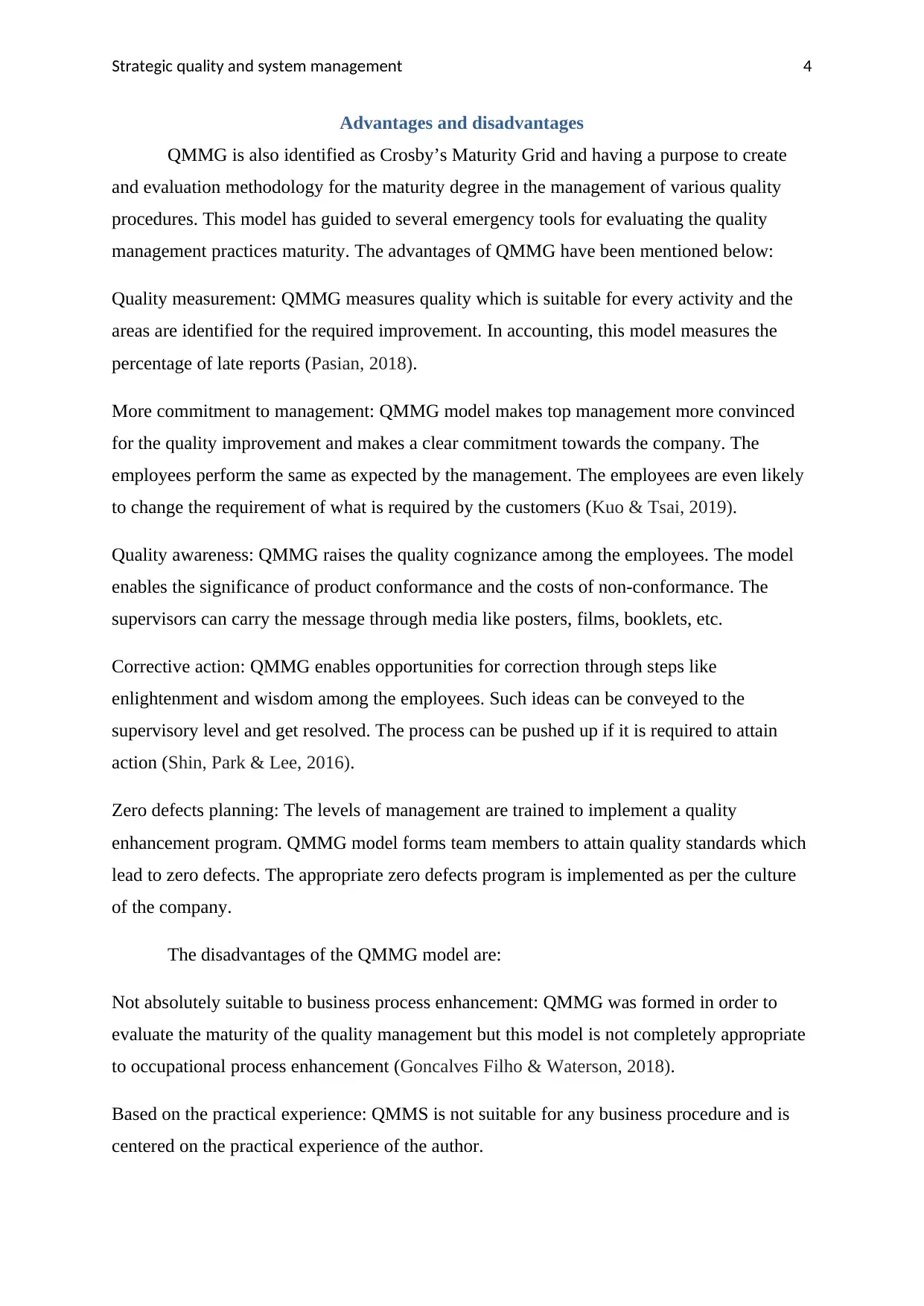
Strategic quality and system management 4
Advantages and disadvantages
QMMG is also identified as Crosby’s Maturity Grid and having a purpose to create
and evaluation methodology for the maturity degree in the management of various quality
procedures. This model has guided to several emergency tools for evaluating the quality
management practices maturity. The advantages of QMMG have been mentioned below:
Quality measurement: QMMG measures quality which is suitable for every activity and the
areas are identified for the required improvement. In accounting, this model measures the
percentage of late reports (Pasian, 2018).
More commitment to management: QMMG model makes top management more convinced
for the quality improvement and makes a clear commitment towards the company. The
employees perform the same as expected by the management. The employees are even likely
to change the requirement of what is required by the customers (Kuo & Tsai, 2019).
Quality awareness: QMMG raises the quality cognizance among the employees. The model
enables the significance of product conformance and the costs of non-conformance. The
supervisors can carry the message through media like posters, films, booklets, etc.
Corrective action: QMMG enables opportunities for correction through steps like
enlightenment and wisdom among the employees. Such ideas can be conveyed to the
supervisory level and get resolved. The process can be pushed up if it is required to attain
action (Shin, Park & Lee, 2016).
Zero defects planning: The levels of management are trained to implement a quality
enhancement program. QMMG model forms team members to attain quality standards which
lead to zero defects. The appropriate zero defects program is implemented as per the culture
of the company.
The disadvantages of the QMMG model are:
Not absolutely suitable to business process enhancement: QMMG was formed in order to
evaluate the maturity of the quality management but this model is not completely appropriate
to occupational process enhancement (Goncalves Filho & Waterson, 2018).
Based on the practical experience: QMMS is not suitable for any business procedure and is
centered on the practical experience of the author.
Advantages and disadvantages
QMMG is also identified as Crosby’s Maturity Grid and having a purpose to create
and evaluation methodology for the maturity degree in the management of various quality
procedures. This model has guided to several emergency tools for evaluating the quality
management practices maturity. The advantages of QMMG have been mentioned below:
Quality measurement: QMMG measures quality which is suitable for every activity and the
areas are identified for the required improvement. In accounting, this model measures the
percentage of late reports (Pasian, 2018).
More commitment to management: QMMG model makes top management more convinced
for the quality improvement and makes a clear commitment towards the company. The
employees perform the same as expected by the management. The employees are even likely
to change the requirement of what is required by the customers (Kuo & Tsai, 2019).
Quality awareness: QMMG raises the quality cognizance among the employees. The model
enables the significance of product conformance and the costs of non-conformance. The
supervisors can carry the message through media like posters, films, booklets, etc.
Corrective action: QMMG enables opportunities for correction through steps like
enlightenment and wisdom among the employees. Such ideas can be conveyed to the
supervisory level and get resolved. The process can be pushed up if it is required to attain
action (Shin, Park & Lee, 2016).
Zero defects planning: The levels of management are trained to implement a quality
enhancement program. QMMG model forms team members to attain quality standards which
lead to zero defects. The appropriate zero defects program is implemented as per the culture
of the company.
The disadvantages of the QMMG model are:
Not absolutely suitable to business process enhancement: QMMG was formed in order to
evaluate the maturity of the quality management but this model is not completely appropriate
to occupational process enhancement (Goncalves Filho & Waterson, 2018).
Based on the practical experience: QMMS is not suitable for any business procedure and is
centered on the practical experience of the author.
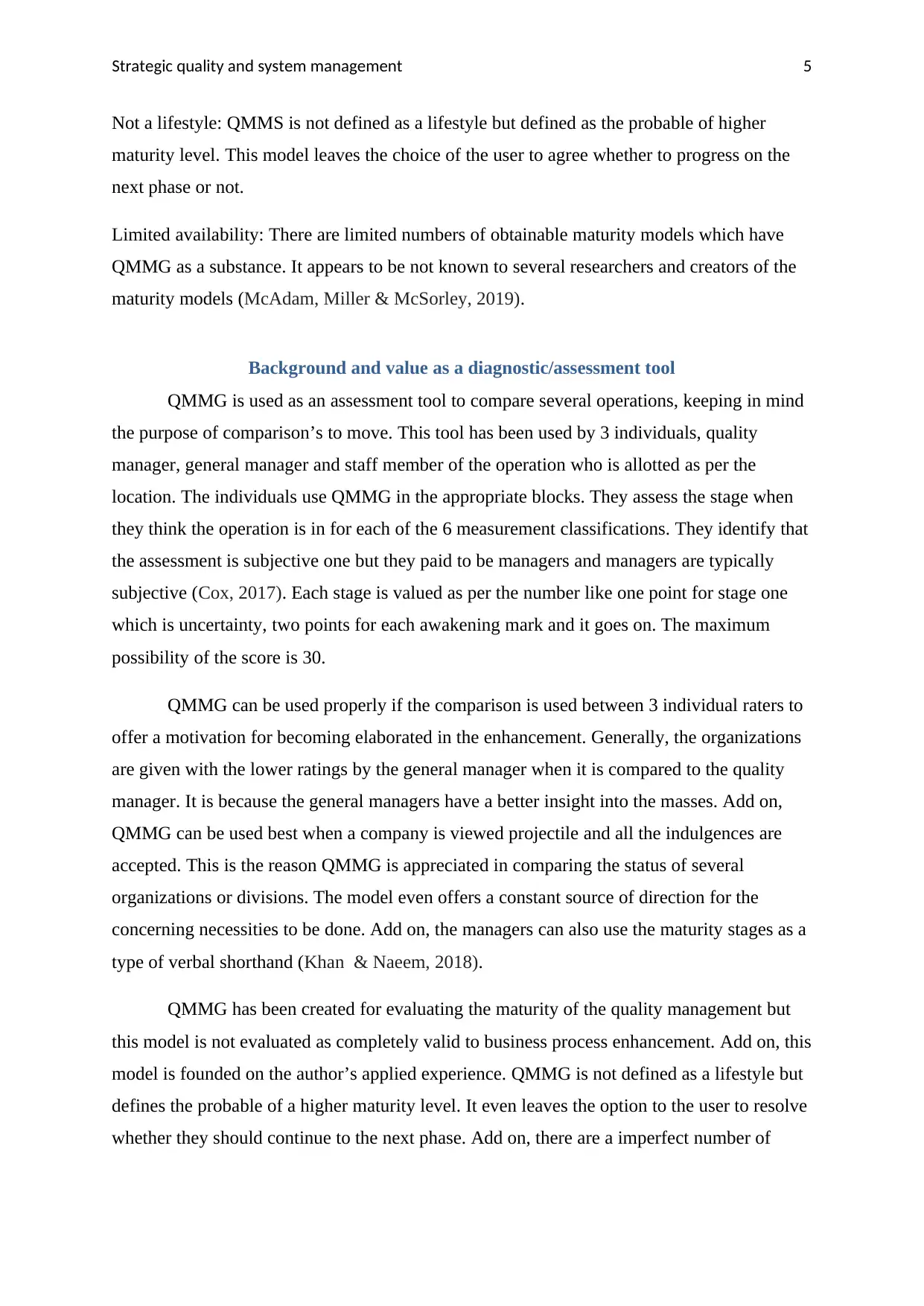
Strategic quality and system management 5
Not a lifestyle: QMMS is not defined as a lifestyle but defined as the probable of higher
maturity level. This model leaves the choice of the user to agree whether to progress on the
next phase or not.
Limited availability: There are limited numbers of obtainable maturity models which have
QMMG as a substance. It appears to be not known to several researchers and creators of the
maturity models (McAdam, Miller & McSorley, 2019).
Background and value as a diagnostic/assessment tool
QMMG is used as an assessment tool to compare several operations, keeping in mind
the purpose of comparison’s to move. This tool has been used by 3 individuals, quality
manager, general manager and staff member of the operation who is allotted as per the
location. The individuals use QMMG in the appropriate blocks. They assess the stage when
they think the operation is in for each of the 6 measurement classifications. They identify that
the assessment is subjective one but they paid to be managers and managers are typically
subjective (Cox, 2017). Each stage is valued as per the number like one point for stage one
which is uncertainty, two points for each awakening mark and it goes on. The maximum
possibility of the score is 30.
QMMG can be used properly if the comparison is used between 3 individual raters to
offer a motivation for becoming elaborated in the enhancement. Generally, the organizations
are given with the lower ratings by the general manager when it is compared to the quality
manager. It is because the general managers have a better insight into the masses. Add on,
QMMG can be used best when a company is viewed projectile and all the indulgences are
accepted. This is the reason QMMG is appreciated in comparing the status of several
organizations or divisions. The model even offers a constant source of direction for the
concerning necessities to be done. Add on, the managers can also use the maturity stages as a
type of verbal shorthand (Khan & Naeem, 2018).
QMMG has been created for evaluating the maturity of the quality management but
this model is not evaluated as completely valid to business process enhancement. Add on, this
model is founded on the author’s applied experience. QMMG is not defined as a lifestyle but
defines the probable of a higher maturity level. It even leaves the option to the user to resolve
whether they should continue to the next phase. Add on, there are a imperfect number of
Not a lifestyle: QMMS is not defined as a lifestyle but defined as the probable of higher
maturity level. This model leaves the choice of the user to agree whether to progress on the
next phase or not.
Limited availability: There are limited numbers of obtainable maturity models which have
QMMG as a substance. It appears to be not known to several researchers and creators of the
maturity models (McAdam, Miller & McSorley, 2019).
Background and value as a diagnostic/assessment tool
QMMG is used as an assessment tool to compare several operations, keeping in mind
the purpose of comparison’s to move. This tool has been used by 3 individuals, quality
manager, general manager and staff member of the operation who is allotted as per the
location. The individuals use QMMG in the appropriate blocks. They assess the stage when
they think the operation is in for each of the 6 measurement classifications. They identify that
the assessment is subjective one but they paid to be managers and managers are typically
subjective (Cox, 2017). Each stage is valued as per the number like one point for stage one
which is uncertainty, two points for each awakening mark and it goes on. The maximum
possibility of the score is 30.
QMMG can be used properly if the comparison is used between 3 individual raters to
offer a motivation for becoming elaborated in the enhancement. Generally, the organizations
are given with the lower ratings by the general manager when it is compared to the quality
manager. It is because the general managers have a better insight into the masses. Add on,
QMMG can be used best when a company is viewed projectile and all the indulgences are
accepted. This is the reason QMMG is appreciated in comparing the status of several
organizations or divisions. The model even offers a constant source of direction for the
concerning necessities to be done. Add on, the managers can also use the maturity stages as a
type of verbal shorthand (Khan & Naeem, 2018).
QMMG has been created for evaluating the maturity of the quality management but
this model is not evaluated as completely valid to business process enhancement. Add on, this
model is founded on the author’s applied experience. QMMG is not defined as a lifestyle but
defines the probable of a higher maturity level. It even leaves the option to the user to resolve
whether they should continue to the next phase. Add on, there are a imperfect number of
⊘ This is a preview!⊘
Do you want full access?
Subscribe today to unlock all pages.

Trusted by 1+ million students worldwide
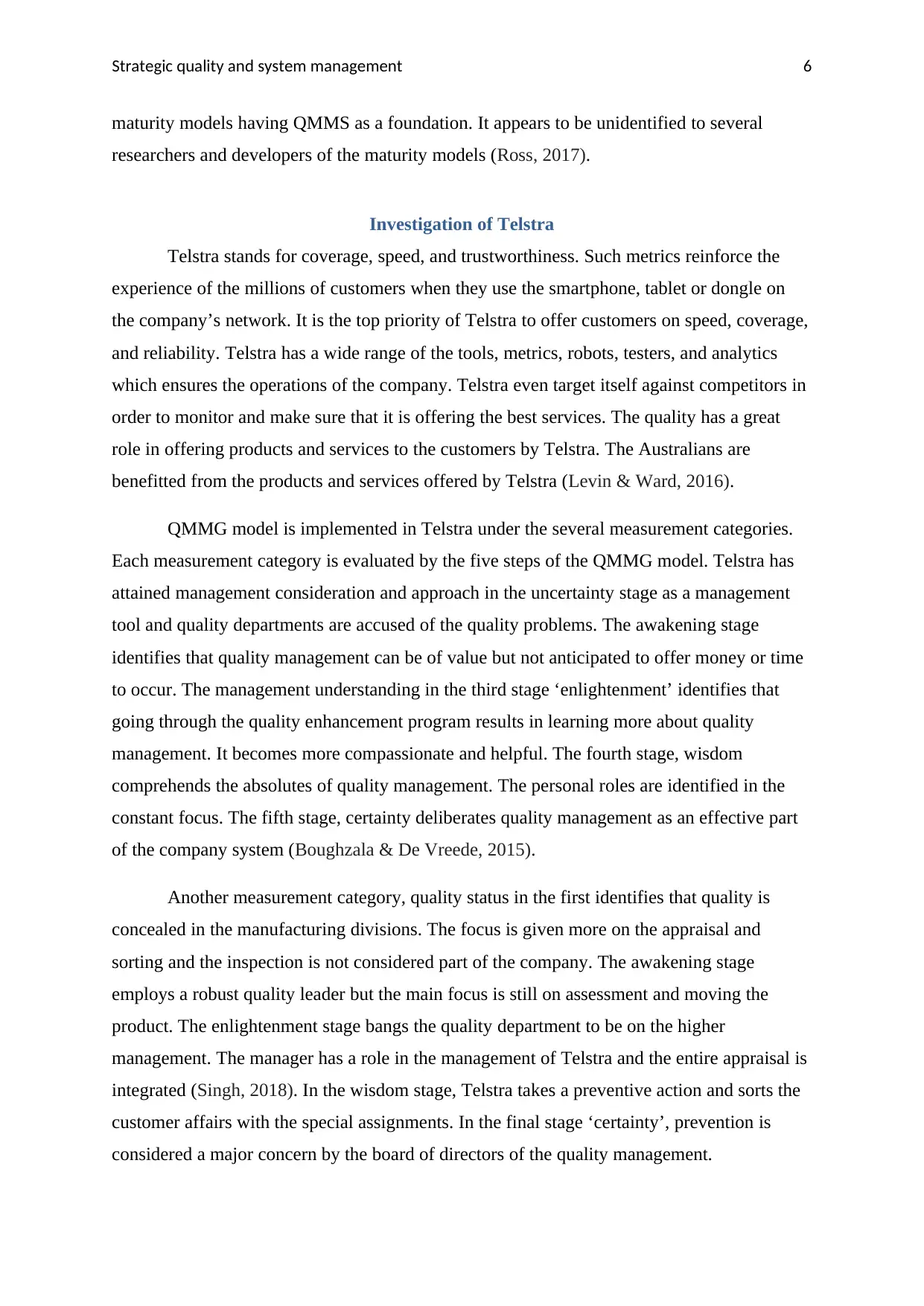
Strategic quality and system management 6
maturity models having QMMS as a foundation. It appears to be unidentified to several
researchers and developers of the maturity models (Ross, 2017).
Investigation of Telstra
Telstra stands for coverage, speed, and trustworthiness. Such metrics reinforce the
experience of the millions of customers when they use the smartphone, tablet or dongle on
the company’s network. It is the top priority of Telstra to offer customers on speed, coverage,
and reliability. Telstra has a wide range of the tools, metrics, robots, testers, and analytics
which ensures the operations of the company. Telstra even target itself against competitors in
order to monitor and make sure that it is offering the best services. The quality has a great
role in offering products and services to the customers by Telstra. The Australians are
benefitted from the products and services offered by Telstra (Levin & Ward, 2016).
QMMG model is implemented in Telstra under the several measurement categories.
Each measurement category is evaluated by the five steps of the QMMG model. Telstra has
attained management consideration and approach in the uncertainty stage as a management
tool and quality departments are accused of the quality problems. The awakening stage
identifies that quality management can be of value but not anticipated to offer money or time
to occur. The management understanding in the third stage ‘enlightenment’ identifies that
going through the quality enhancement program results in learning more about quality
management. It becomes more compassionate and helpful. The fourth stage, wisdom
comprehends the absolutes of quality management. The personal roles are identified in the
constant focus. The fifth stage, certainty deliberates quality management as an effective part
of the company system (Boughzala & De Vreede, 2015).
Another measurement category, quality status in the first identifies that quality is
concealed in the manufacturing divisions. The focus is given more on the appraisal and
sorting and the inspection is not considered part of the company. The awakening stage
employs a robust quality leader but the main focus is still on assessment and moving the
product. The enlightenment stage bangs the quality department to be on the higher
management. The manager has a role in the management of Telstra and the entire appraisal is
integrated (Singh, 2018). In the wisdom stage, Telstra takes a preventive action and sorts the
customer affairs with the special assignments. In the final stage ‘certainty’, prevention is
considered a major concern by the board of directors of the quality management.
maturity models having QMMS as a foundation. It appears to be unidentified to several
researchers and developers of the maturity models (Ross, 2017).
Investigation of Telstra
Telstra stands for coverage, speed, and trustworthiness. Such metrics reinforce the
experience of the millions of customers when they use the smartphone, tablet or dongle on
the company’s network. It is the top priority of Telstra to offer customers on speed, coverage,
and reliability. Telstra has a wide range of the tools, metrics, robots, testers, and analytics
which ensures the operations of the company. Telstra even target itself against competitors in
order to monitor and make sure that it is offering the best services. The quality has a great
role in offering products and services to the customers by Telstra. The Australians are
benefitted from the products and services offered by Telstra (Levin & Ward, 2016).
QMMG model is implemented in Telstra under the several measurement categories.
Each measurement category is evaluated by the five steps of the QMMG model. Telstra has
attained management consideration and approach in the uncertainty stage as a management
tool and quality departments are accused of the quality problems. The awakening stage
identifies that quality management can be of value but not anticipated to offer money or time
to occur. The management understanding in the third stage ‘enlightenment’ identifies that
going through the quality enhancement program results in learning more about quality
management. It becomes more compassionate and helpful. The fourth stage, wisdom
comprehends the absolutes of quality management. The personal roles are identified in the
constant focus. The fifth stage, certainty deliberates quality management as an effective part
of the company system (Boughzala & De Vreede, 2015).
Another measurement category, quality status in the first identifies that quality is
concealed in the manufacturing divisions. The focus is given more on the appraisal and
sorting and the inspection is not considered part of the company. The awakening stage
employs a robust quality leader but the main focus is still on assessment and moving the
product. The enlightenment stage bangs the quality department to be on the higher
management. The manager has a role in the management of Telstra and the entire appraisal is
integrated (Singh, 2018). In the wisdom stage, Telstra takes a preventive action and sorts the
customer affairs with the special assignments. In the final stage ‘certainty’, prevention is
considered a major concern by the board of directors of the quality management.
Paraphrase This Document
Need a fresh take? Get an instant paraphrase of this document with our AI Paraphraser
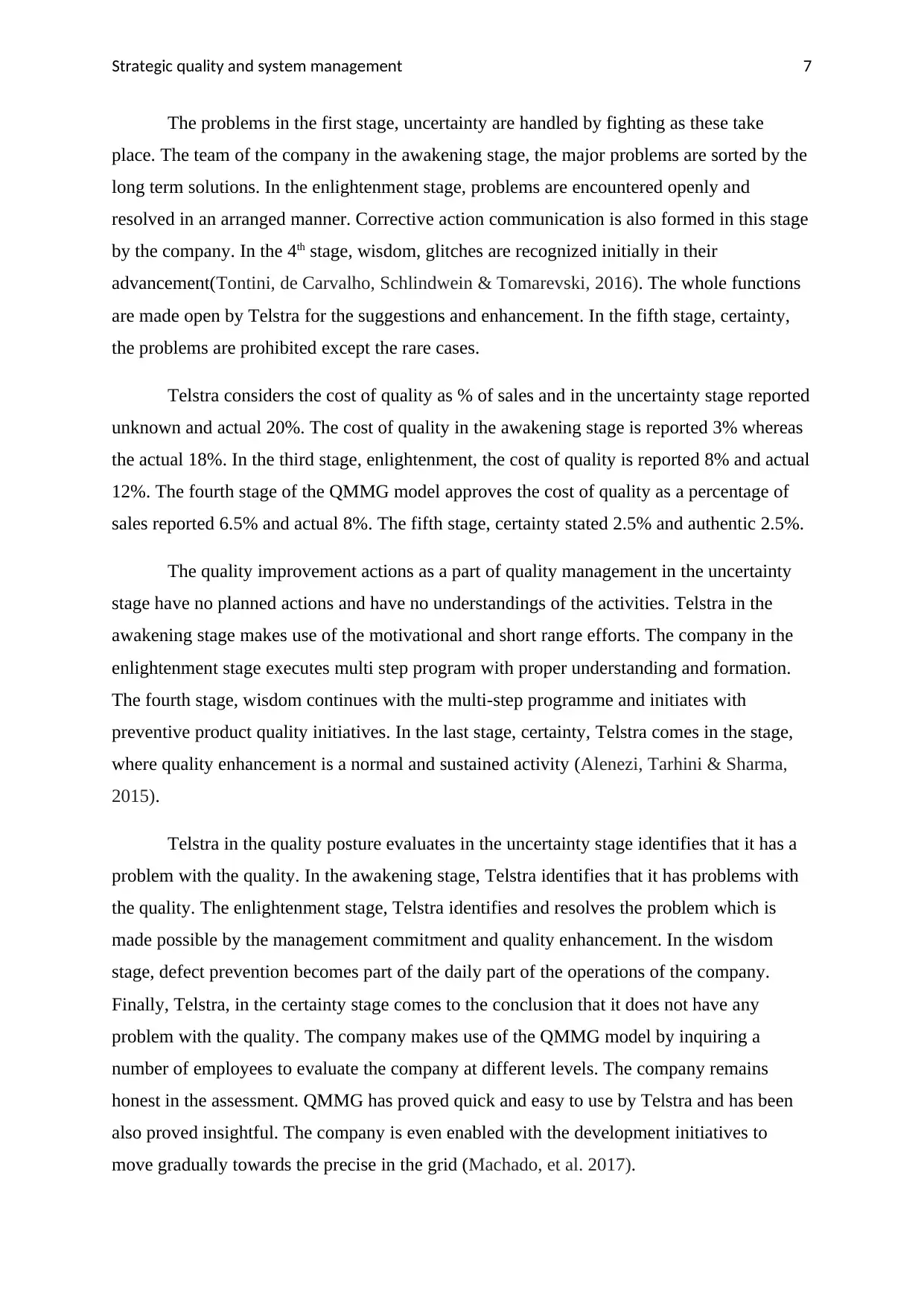
Strategic quality and system management 7
The problems in the first stage, uncertainty are handled by fighting as these take
place. The team of the company in the awakening stage, the major problems are sorted by the
long term solutions. In the enlightenment stage, problems are encountered openly and
resolved in an arranged manner. Corrective action communication is also formed in this stage
by the company. In the 4th stage, wisdom, glitches are recognized initially in their
advancement(Tontini, de Carvalho, Schlindwein & Tomarevski, 2016). The whole functions
are made open by Telstra for the suggestions and enhancement. In the fifth stage, certainty,
the problems are prohibited except the rare cases.
Telstra considers the cost of quality as % of sales and in the uncertainty stage reported
unknown and actual 20%. The cost of quality in the awakening stage is reported 3% whereas
the actual 18%. In the third stage, enlightenment, the cost of quality is reported 8% and actual
12%. The fourth stage of the QMMG model approves the cost of quality as a percentage of
sales reported 6.5% and actual 8%. The fifth stage, certainty stated 2.5% and authentic 2.5%.
The quality improvement actions as a part of quality management in the uncertainty
stage have no planned actions and have no understandings of the activities. Telstra in the
awakening stage makes use of the motivational and short range efforts. The company in the
enlightenment stage executes multi step program with proper understanding and formation.
The fourth stage, wisdom continues with the multi-step programme and initiates with
preventive product quality initiatives. In the last stage, certainty, Telstra comes in the stage,
where quality enhancement is a normal and sustained activity (Alenezi, Tarhini & Sharma,
2015).
Telstra in the quality posture evaluates in the uncertainty stage identifies that it has a
problem with the quality. In the awakening stage, Telstra identifies that it has problems with
the quality. The enlightenment stage, Telstra identifies and resolves the problem which is
made possible by the management commitment and quality enhancement. In the wisdom
stage, defect prevention becomes part of the daily part of the operations of the company.
Finally, Telstra, in the certainty stage comes to the conclusion that it does not have any
problem with the quality. The company makes use of the QMMG model by inquiring a
number of employees to evaluate the company at different levels. The company remains
honest in the assessment. QMMG has proved quick and easy to use by Telstra and has been
also proved insightful. The company is even enabled with the development initiatives to
move gradually towards the precise in the grid (Machado, et al. 2017).
The problems in the first stage, uncertainty are handled by fighting as these take
place. The team of the company in the awakening stage, the major problems are sorted by the
long term solutions. In the enlightenment stage, problems are encountered openly and
resolved in an arranged manner. Corrective action communication is also formed in this stage
by the company. In the 4th stage, wisdom, glitches are recognized initially in their
advancement(Tontini, de Carvalho, Schlindwein & Tomarevski, 2016). The whole functions
are made open by Telstra for the suggestions and enhancement. In the fifth stage, certainty,
the problems are prohibited except the rare cases.
Telstra considers the cost of quality as % of sales and in the uncertainty stage reported
unknown and actual 20%. The cost of quality in the awakening stage is reported 3% whereas
the actual 18%. In the third stage, enlightenment, the cost of quality is reported 8% and actual
12%. The fourth stage of the QMMG model approves the cost of quality as a percentage of
sales reported 6.5% and actual 8%. The fifth stage, certainty stated 2.5% and authentic 2.5%.
The quality improvement actions as a part of quality management in the uncertainty
stage have no planned actions and have no understandings of the activities. Telstra in the
awakening stage makes use of the motivational and short range efforts. The company in the
enlightenment stage executes multi step program with proper understanding and formation.
The fourth stage, wisdom continues with the multi-step programme and initiates with
preventive product quality initiatives. In the last stage, certainty, Telstra comes in the stage,
where quality enhancement is a normal and sustained activity (Alenezi, Tarhini & Sharma,
2015).
Telstra in the quality posture evaluates in the uncertainty stage identifies that it has a
problem with the quality. In the awakening stage, Telstra identifies that it has problems with
the quality. The enlightenment stage, Telstra identifies and resolves the problem which is
made possible by the management commitment and quality enhancement. In the wisdom
stage, defect prevention becomes part of the daily part of the operations of the company.
Finally, Telstra, in the certainty stage comes to the conclusion that it does not have any
problem with the quality. The company makes use of the QMMG model by inquiring a
number of employees to evaluate the company at different levels. The company remains
honest in the assessment. QMMG has proved quick and easy to use by Telstra and has been
also proved insightful. The company is even enabled with the development initiatives to
move gradually towards the precise in the grid (Machado, et al. 2017).
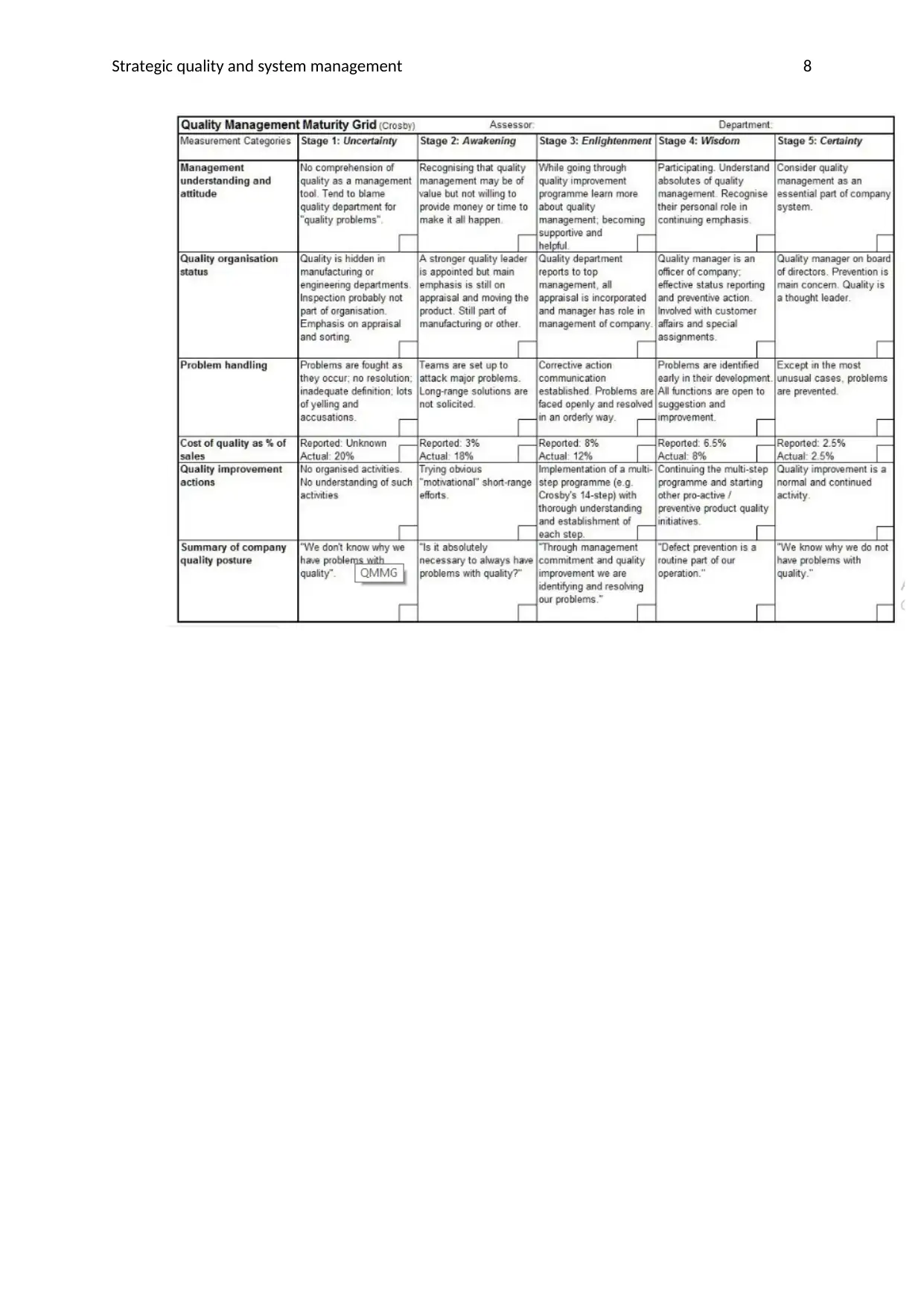
Strategic quality and system management 8
⊘ This is a preview!⊘
Do you want full access?
Subscribe today to unlock all pages.

Trusted by 1+ million students worldwide
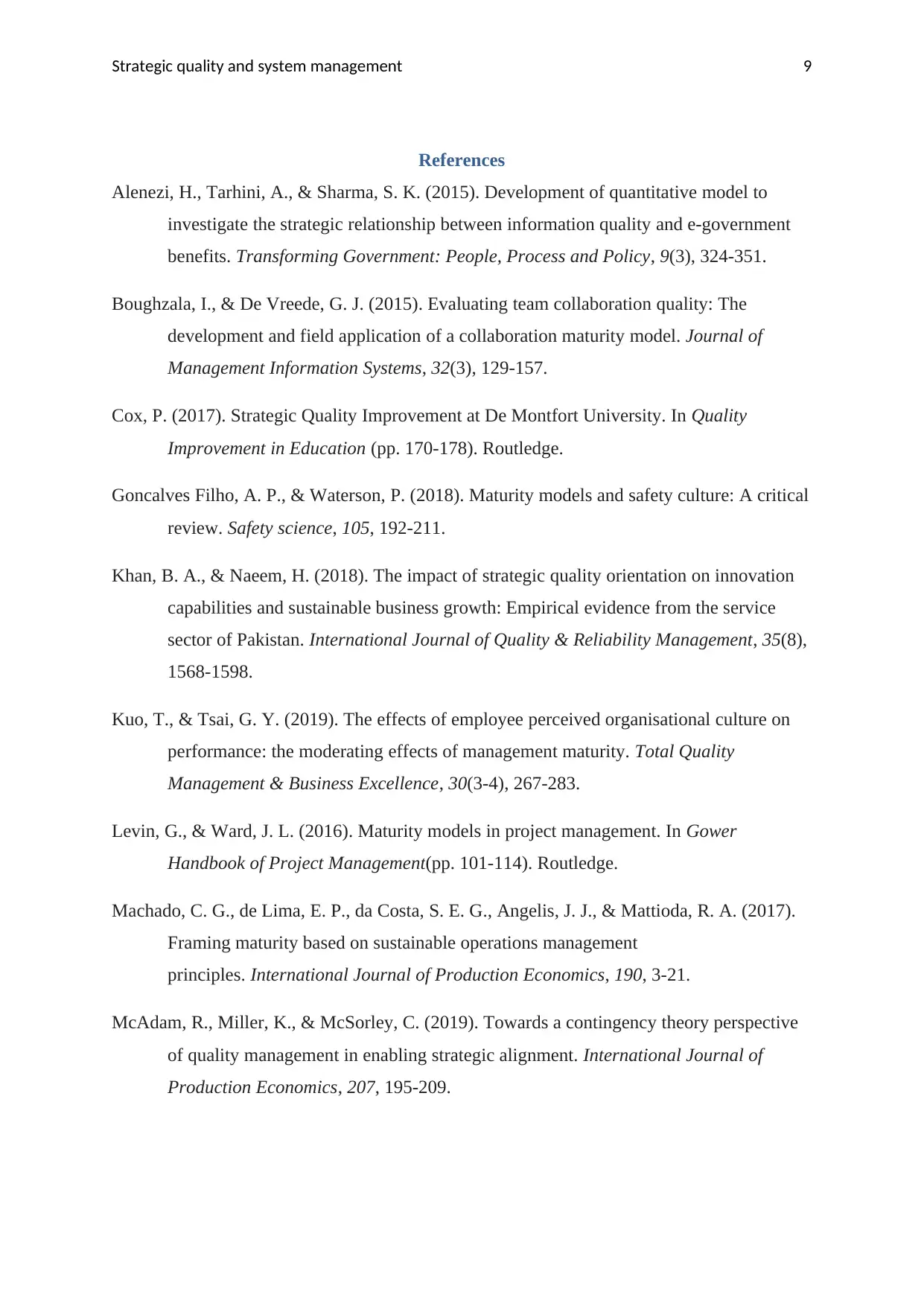
Strategic quality and system management 9
References
Alenezi, H., Tarhini, A., & Sharma, S. K. (2015). Development of quantitative model to
investigate the strategic relationship between information quality and e-government
benefits. Transforming Government: People, Process and Policy, 9(3), 324-351.
Boughzala, I., & De Vreede, G. J. (2015). Evaluating team collaboration quality: The
development and field application of a collaboration maturity model. Journal of
Management Information Systems, 32(3), 129-157.
Cox, P. (2017). Strategic Quality Improvement at De Montfort University. In Quality
Improvement in Education (pp. 170-178). Routledge.
Goncalves Filho, A. P., & Waterson, P. (2018). Maturity models and safety culture: A critical
review. Safety science, 105, 192-211.
Khan, B. A., & Naeem, H. (2018). The impact of strategic quality orientation on innovation
capabilities and sustainable business growth: Empirical evidence from the service
sector of Pakistan. International Journal of Quality & Reliability Management, 35(8),
1568-1598.
Kuo, T., & Tsai, G. Y. (2019). The effects of employee perceived organisational culture on
performance: the moderating effects of management maturity. Total Quality
Management & Business Excellence, 30(3-4), 267-283.
Levin, G., & Ward, J. L. (2016). Maturity models in project management. In Gower
Handbook of Project Management(pp. 101-114). Routledge.
Machado, C. G., de Lima, E. P., da Costa, S. E. G., Angelis, J. J., & Mattioda, R. A. (2017).
Framing maturity based on sustainable operations management
principles. International Journal of Production Economics, 190, 3-21.
McAdam, R., Miller, K., & McSorley, C. (2019). Towards a contingency theory perspective
of quality management in enabling strategic alignment. International Journal of
Production Economics, 207, 195-209.
References
Alenezi, H., Tarhini, A., & Sharma, S. K. (2015). Development of quantitative model to
investigate the strategic relationship between information quality and e-government
benefits. Transforming Government: People, Process and Policy, 9(3), 324-351.
Boughzala, I., & De Vreede, G. J. (2015). Evaluating team collaboration quality: The
development and field application of a collaboration maturity model. Journal of
Management Information Systems, 32(3), 129-157.
Cox, P. (2017). Strategic Quality Improvement at De Montfort University. In Quality
Improvement in Education (pp. 170-178). Routledge.
Goncalves Filho, A. P., & Waterson, P. (2018). Maturity models and safety culture: A critical
review. Safety science, 105, 192-211.
Khan, B. A., & Naeem, H. (2018). The impact of strategic quality orientation on innovation
capabilities and sustainable business growth: Empirical evidence from the service
sector of Pakistan. International Journal of Quality & Reliability Management, 35(8),
1568-1598.
Kuo, T., & Tsai, G. Y. (2019). The effects of employee perceived organisational culture on
performance: the moderating effects of management maturity. Total Quality
Management & Business Excellence, 30(3-4), 267-283.
Levin, G., & Ward, J. L. (2016). Maturity models in project management. In Gower
Handbook of Project Management(pp. 101-114). Routledge.
Machado, C. G., de Lima, E. P., da Costa, S. E. G., Angelis, J. J., & Mattioda, R. A. (2017).
Framing maturity based on sustainable operations management
principles. International Journal of Production Economics, 190, 3-21.
McAdam, R., Miller, K., & McSorley, C. (2019). Towards a contingency theory perspective
of quality management in enabling strategic alignment. International Journal of
Production Economics, 207, 195-209.
Paraphrase This Document
Need a fresh take? Get an instant paraphrase of this document with our AI Paraphraser
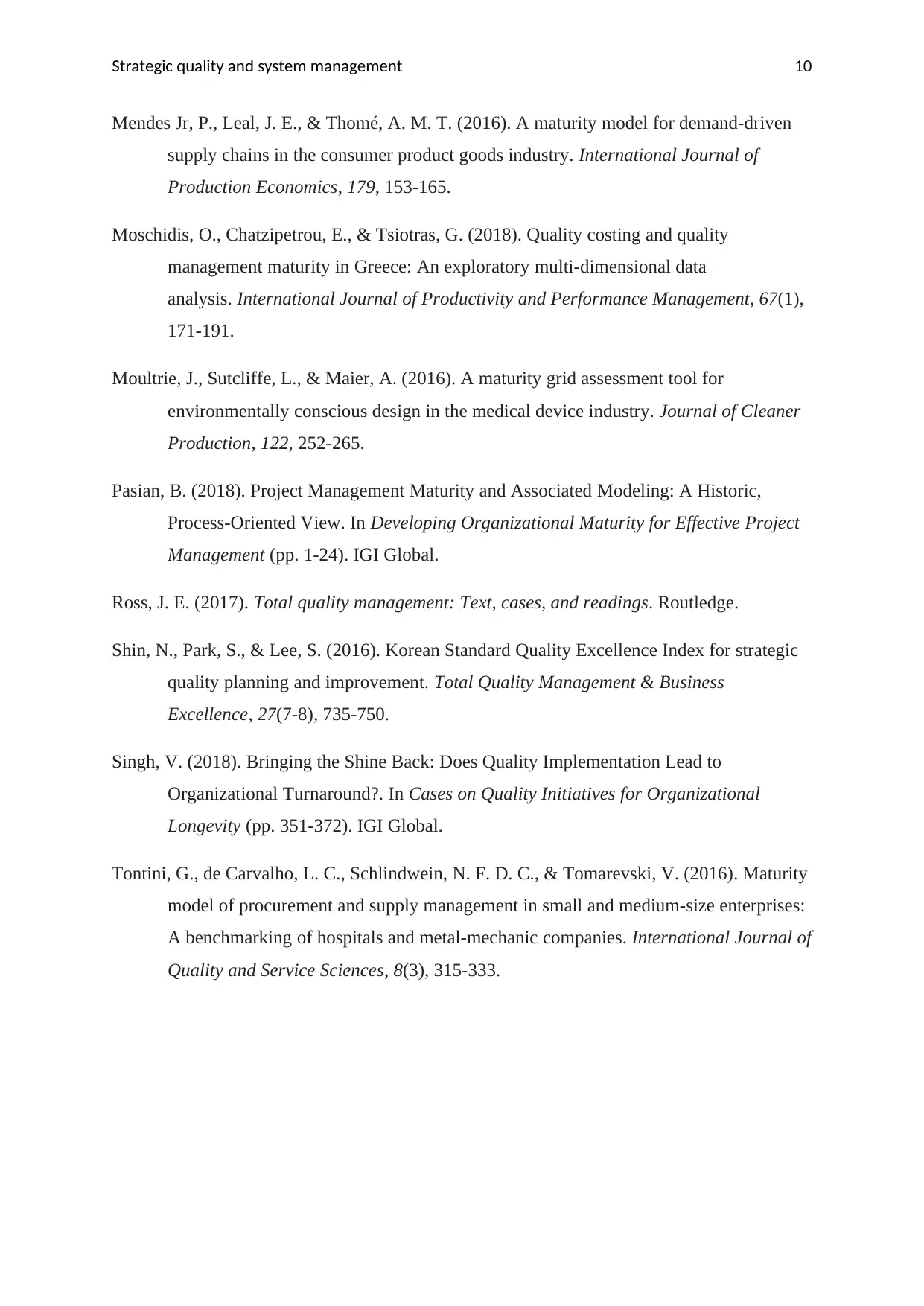
Strategic quality and system management 10
Mendes Jr, P., Leal, J. E., & Thomé, A. M. T. (2016). A maturity model for demand-driven
supply chains in the consumer product goods industry. International Journal of
Production Economics, 179, 153-165.
Moschidis, O., Chatzipetrou, E., & Tsiotras, G. (2018). Quality costing and quality
management maturity in Greece: An exploratory multi-dimensional data
analysis. International Journal of Productivity and Performance Management, 67(1),
171-191.
Moultrie, J., Sutcliffe, L., & Maier, A. (2016). A maturity grid assessment tool for
environmentally conscious design in the medical device industry. Journal of Cleaner
Production, 122, 252-265.
Pasian, B. (2018). Project Management Maturity and Associated Modeling: A Historic,
Process-Oriented View. In Developing Organizational Maturity for Effective Project
Management (pp. 1-24). IGI Global.
Ross, J. E. (2017). Total quality management: Text, cases, and readings. Routledge.
Shin, N., Park, S., & Lee, S. (2016). Korean Standard Quality Excellence Index for strategic
quality planning and improvement. Total Quality Management & Business
Excellence, 27(7-8), 735-750.
Singh, V. (2018). Bringing the Shine Back: Does Quality Implementation Lead to
Organizational Turnaround?. In Cases on Quality Initiatives for Organizational
Longevity (pp. 351-372). IGI Global.
Tontini, G., de Carvalho, L. C., Schlindwein, N. F. D. C., & Tomarevski, V. (2016). Maturity
model of procurement and supply management in small and medium-size enterprises:
A benchmarking of hospitals and metal-mechanic companies. International Journal of
Quality and Service Sciences, 8(3), 315-333.
Mendes Jr, P., Leal, J. E., & Thomé, A. M. T. (2016). A maturity model for demand-driven
supply chains in the consumer product goods industry. International Journal of
Production Economics, 179, 153-165.
Moschidis, O., Chatzipetrou, E., & Tsiotras, G. (2018). Quality costing and quality
management maturity in Greece: An exploratory multi-dimensional data
analysis. International Journal of Productivity and Performance Management, 67(1),
171-191.
Moultrie, J., Sutcliffe, L., & Maier, A. (2016). A maturity grid assessment tool for
environmentally conscious design in the medical device industry. Journal of Cleaner
Production, 122, 252-265.
Pasian, B. (2018). Project Management Maturity and Associated Modeling: A Historic,
Process-Oriented View. In Developing Organizational Maturity for Effective Project
Management (pp. 1-24). IGI Global.
Ross, J. E. (2017). Total quality management: Text, cases, and readings. Routledge.
Shin, N., Park, S., & Lee, S. (2016). Korean Standard Quality Excellence Index for strategic
quality planning and improvement. Total Quality Management & Business
Excellence, 27(7-8), 735-750.
Singh, V. (2018). Bringing the Shine Back: Does Quality Implementation Lead to
Organizational Turnaround?. In Cases on Quality Initiatives for Organizational
Longevity (pp. 351-372). IGI Global.
Tontini, G., de Carvalho, L. C., Schlindwein, N. F. D. C., & Tomarevski, V. (2016). Maturity
model of procurement and supply management in small and medium-size enterprises:
A benchmarking of hospitals and metal-mechanic companies. International Journal of
Quality and Service Sciences, 8(3), 315-333.
1 out of 11
Your All-in-One AI-Powered Toolkit for Academic Success.
+13062052269
info@desklib.com
Available 24*7 on WhatsApp / Email
![[object Object]](/_next/static/media/star-bottom.7253800d.svg)
Unlock your academic potential
Copyright © 2020–2025 A2Z Services. All Rights Reserved. Developed and managed by ZUCOL.